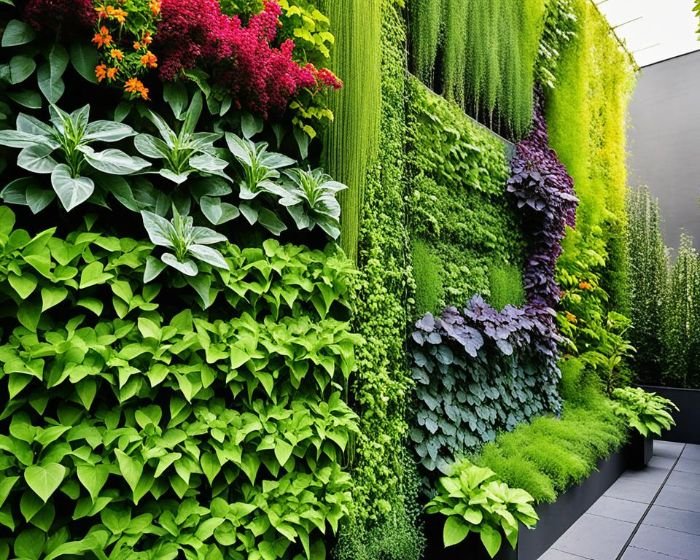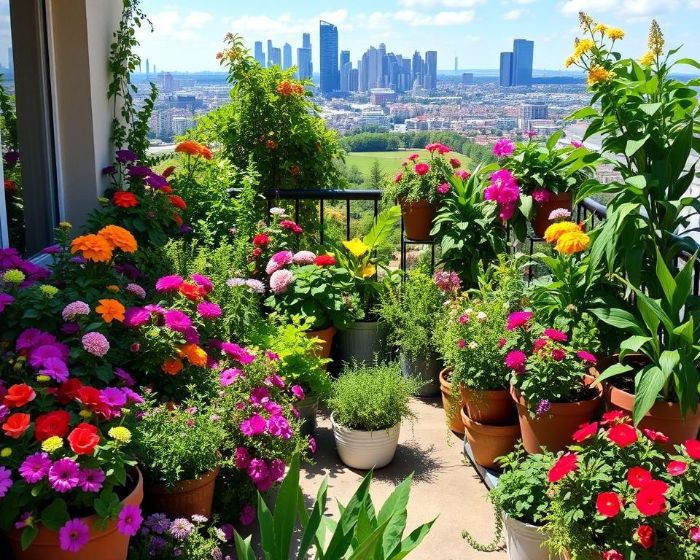Did you know that vertical gardening can increase the usable space in your small urban area by up to 400%? That’s right – with vertical gardening techniques, you can transform a cramped balcony or tiny garden into a vibrant oasis, overflowing with lush greenery and colorful blooms. Say goodbye to limited space woes and hello to an abundance of plants thriving in even the smallest of areas.
Key Takeaways:
- Vertical gardening allows you to maximize limited space in urban areas and create beautiful green environments.
- By growing plants vertically along walls, fences, and trellises, you can significantly increase the usable area for gardening.
- Vertical gardens offer numerous benefits, including maximizing space utilization, creating privacy barriers, enhancing the beauty of your space, and reducing the risk of pests and diseases.
- Designing a successful vertical garden involves choosing the right structure, selecting suitable plants, ensuring adequate light and water, and regular maintenance.
- Case studies of successful urban vertical gardens can provide inspiration and insights for transforming small spaces into thriving green oases.
Table of Contents
The Rise of Vertical Gardening in Urban Landscapes
Vertical gardening is gaining popularity in urban landscapes as a creative solution for maximizing space utilization and creating green areas in small and limited spaces. By growing plants upwards along vertical surfaces such as walls, fences, and trellises, urban dwellers can transform their surroundings into vibrant and lush gardens.
Understanding Vertical Gardening – Basics and Benefits
Vertical gardening involves the cultivation of plants in a vertical arrangement, instead of traditional horizontal planting. By utilizing vertical space, garden enthusiasts can optimize the use of limited areas while still enjoying the beauty and benefits of a flourishing garden. Key elements of vertical gardening include selecting the right plants, choosing suitable structures, and ensuring adequate lighting and irrigation.
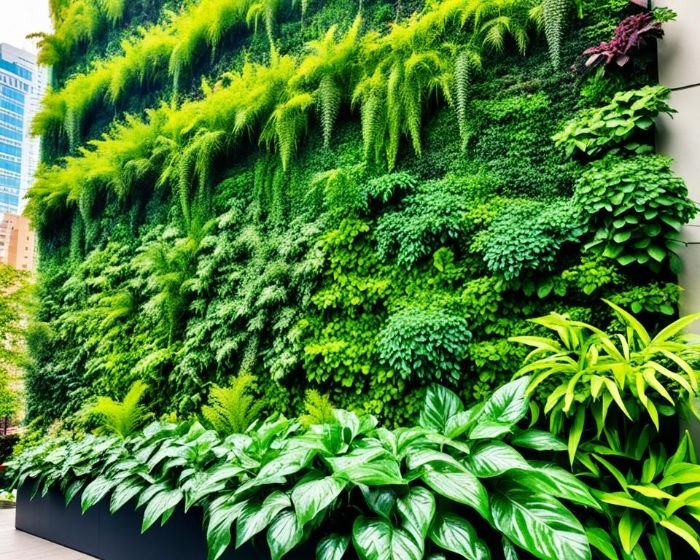
Why Vertical Gardens Are Ideal for Urban Environments
Vertical gardens are particularly well-suited for urban environments due to their numerous advantages. One of the primary benefits is the efficient use of available space, allowing individuals to create gardens even in the smallest of areas. Vertical gardens also enhance the aesthetics of urban spaces, adding a touch of nature and color to typically concrete surroundings. Moreover, these green walls contribute to air purification, reduce noise pollution, and provide a sense of well-being for urban residents.
Whether you have a small balcony, rooftop, or a tiny courtyard, vertical gardening offers a practical and visually appealing solution for incorporating plants into urban living. Let’s explore the design principles, innovative ideas, and maintenance tips that will help you create and sustain thriving vertical gardens in limited spaces.
Design Principles of Vertical Gardening
Designing a successful vertical garden involves considering important principles such as choosing the right structure and selecting suitable plants. By carefully planning and implementing these design principles, you can create a thriving and visually appealing vertical garden in any limited space.
Choosing the Right Structure for Your Space
When selecting a structure for your vertical garden, it is essential to take into account factors such as the available space, weight-bearing capacity, and aesthetics. There are various options to choose from, depending on your specific requirements and preferences:
- Trellises – These vertical structures offer support for climbing plants, allowing them to grow vertically along the trellis. They are particularly suitable for lightweight plants and are available in various materials, such as wood, metal, or PVC.
- Arbors – Arbors provide an elegant and decorative vertical element to your garden. They can be used as a standalone structure or incorporated into existing fences or walls, allowing vines and climbers to create a stunning green backdrop.
- Hanging Containers – Hanging containers are an excellent choice for vertical gardening in limited spaces. They can be suspended from walls, fences, or pergolas, adding a touch of beauty and functionality to your vertical garden.
- Stackable Planters – Stackable planters are a space-saving solution that allows you to create vertical layers of plants. These modular systems are designed to maximize growing space while maintaining an organized and visually appealing garden.
Consider the specific needs and limitations of your space when selecting the right structure for your vertical garden. It is important to ensure that the structure can support the weight of the plants and is suitable for the available area.
Plant Selection for Vertical Gardens
The selection of plants plays a crucial role in the success of your vertical garden. When choosing plants for vertical growth, it is essential to consider their growth habits, adaptability to confined spaces, and overall suitability. Here are some factors to keep in mind:
- Vertical Growth – Choose plants that naturally grow vertically or those that can be trained and supported along the structure. Vines, climbers, and trailing plants are excellent choices.
- Compact Growth Habits – Opt for plants with compact growth habits to ensure they don’t overpower the vertical structure and overcrowd the garden. Look for varieties that have bushy or upright growth patterns.
- Suitability for Confined Spaces – Some plants are better suited for confined spaces and can thrive in containers or narrow beds. Consider their root systems and growth requirements before selecting them for your vertical garden.
- Light and Water Requirements – Different plants have varying light and water requirements. Ensure that the selected plants are compatible with the available sunlight and water resources in your vertical garden.
- Aesthetic Appeal – Choose plants that not only fit the vertical structure but also enhance the overall visual appeal of your garden. Consider factors such as flower colors, foliage textures, and seasonal interest.
By carefully considering these factors and selecting plants that are well-suited for vertical gardening, you can create a diverse and thriving vertical garden that adds beauty and greenery to any limited space.
Innovative Ideas for Vertical Gardening
Vertical gardening opens up a world of possibilities for maximizing space and adding visual appeal in small areas. With a touch of creativity and a few innovative ideas, you can transform your limited space into a thriving vertical garden that will astound and inspire. Whether you have a small balcony, patio, or even a sunny kitchen window, there are exciting DIY projects and opportunities to incorporate edible plants that will take your vertical garden to the next level.
DIY Vertical Garden Projects for Small Spaces
One of the most exciting aspects of vertical gardening is the opportunity to create your own unique structures using cost-effective and readily available materials. DIY vertical garden projects not only allow you to customize your garden to suit your personal style but also provide a sense of accomplishment and pride in creating something truly one-of-a-kind.
One popular DIY project idea is using pallets as a vertical garden framework. Pallets can be easily transformed into vertical planters by attaching pots or plant pockets to the slats. Not only does this maximize space, but it also adds a rustic and charming touch to your garden. Another option is repurposing old wooden frames or ladders as vertical garden structures. Hang pots or attach planters to different levels for an artistic and eye-catching display.
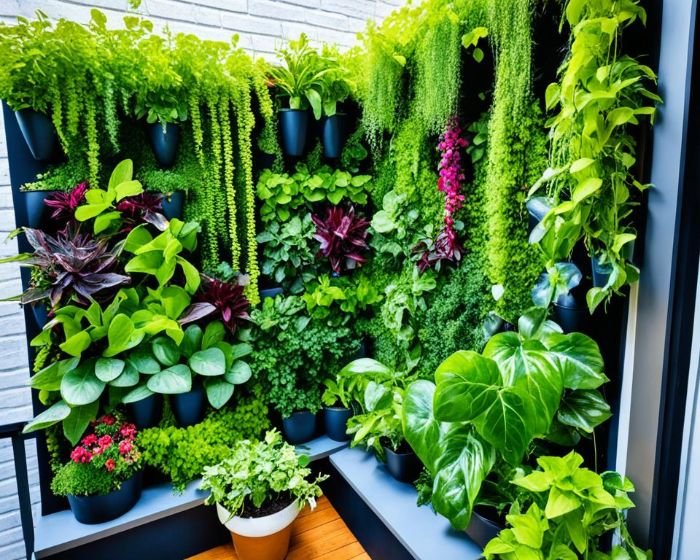
Incorporating Edible Plants and Herbs in Vertical Gardens
Vertical gardens present an exciting opportunity to combine beauty with functionality by incorporating edible plants and herbs in your garden. Growing your own food not only benefits the environment but also allows you to have a fresh and sustainable source of nourishment right at your fingertips.
When it comes to edible plants, consider growing compact varieties that thrive in confined spaces. Vegetables such as cherry tomatoes, lettuces, and peppers are well-suited for vertical gardening. Herbs like basil, mint, and rosemary can also be grown in hanging containers or vertically stacked planters, adding a delightful fragrance to your garden.
Imagine the joy of harvesting your own herbs and vegetables from your vertical garden, knowing that they are free from chemicals and full of flavor. Incorporating edible plants and herbs not only adds practicality to your vertical garden but also enhances the overall sensory experience of your space.
Overcoming Challenges in Vertical Gardening
Vertical gardening offers a unique set of challenges that gardeners must overcome to ensure the success of their vertical gardens. Two crucial aspects to consider are adequate light and water supply, along with proper maintenance tips to keep your vertical garden thriving.
Ensuring Adequate Light and Water
Proper lighting is essential for the healthy growth of plants in vertical gardens. When positioning your vertical garden, consider the orientation of the structure, available sunlight, and the light requirements of your plants. For areas with limited natural light, supplemental lighting may be necessary to provide adequate illumination.
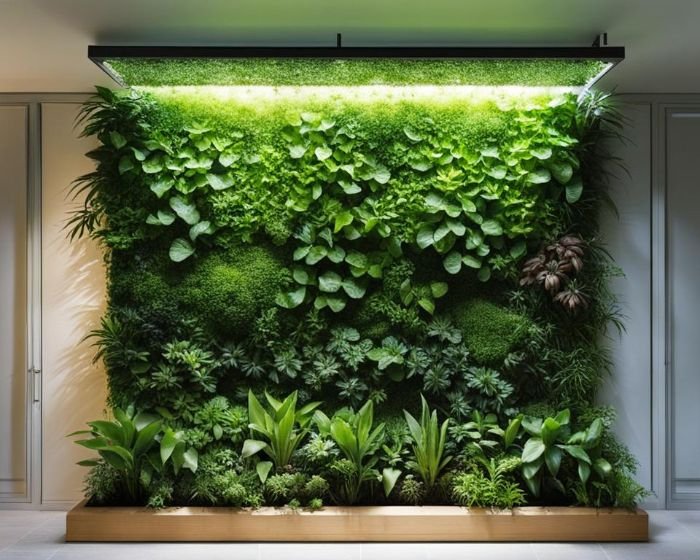
Watering vertical gardens can be challenging due to the unique structure and potential water runoff. Implementing an efficient irrigation system is essential to ensure your plants receive adequate moisture. Consider the water needs of different plants in your vertical garden and monitor soil moisture levels regularly to prevent under or overwatering.
Maintenance Tips for a Thriving Vertical Garden
Maintaining your vertical garden is crucial for its long-term health and beauty. Regular maintenance tasks such as pruning, fertilizing, and pest control are necessary to keep your plants thriving. Monitor the growth of your plants and trim any overgrown or damaged parts to maintain their aesthetic appeal and prevent overcrowding.
Additionally, provide appropriate fertilization to replenish nutrients in the soil and promote healthy plant growth. Consider organic fertilizers or slow-release fertilizers specifically formulated for vertical gardens.
By ensuring adequate light and water and implementing proper maintenance practices, you can overcome the challenges of vertical gardening and create a flourishing oasis in even the most limited spaces.
Case Studies – Successful Urban Vertical Gardens
Transforming small spaces into lush and thriving urban gardens is made possible through the innovative technique of vertical gardening. Let’s explore some inspiring case studies that showcase the remarkable results achieved by implementing vertical gardening in limited urban environments.
Transforming Spaces – Before and After
By incorporating vertical gardening techniques, small balconies have been transformed into vibrant green oases, offering a refreshing escape amidst the bustling cityscape. One such example is Sarah’s balcony in downtown Manhattan. Previously a neglected space, it now flourishes with an array of vertical planters filled with colorful flowers, cascading vines, and aromatic herbs. The transformation of this small balcony has not only enhanced Sarah’s living environment but has also become a picturesque focal point within the urban landscape.
In addition, walls in urban neighborhoods have been adorned with stunning vertical gardens, adding beauty and character to otherwise plain surfaces. A notable example is the Green Wall project in Los Angeles. What was once a dull and neglected wall is now an awe-inspiring sight, covered in a tapestry of lush greenery. This vertical garden not only improves the visual appeal of the neighborhood but also contributes to air purification and creates a habitat for beneficial insects and birds.
Small gardens have also experienced a complete transformation through vertical gardening. Take, for instance, Michael’s backyard in Chicago. With limited space, he turned to vertical gardening to maximize his garden’s potential. By utilizing stackable planters and trellises, Michael now enjoys a thriving and productive garden that supplies fresh vegetables, juicy fruits, and fragrant flowers. This transformation has not only provided a source of homegrown produce but has also become a source of pride and satisfaction for Michael and his family.
Lessons Learned from Urban Vertical Gardening Projects
From these successful case studies, several valuable lessons can be learned for aspiring vertical gardeners. Firstly, it is crucial to carefully consider plant selection, ensuring that the chosen plants are suitable for vertical growth and can thrive in confined spaces. Understanding the sunlight requirements, water needs, and growth habits of the plants is essential for a flourishing vertical garden.
Secondly, proper planning and structure selection play a vital role in the success of a vertical garden. Assessing the available space, weight-bearing capacity, and aesthetics of the chosen structures will contribute to a functional and visually appealing design. Incorporating repurposed materials and DIY projects can add a unique touch, as demonstrated by the numerous successful DIY vertical garden projects.
Lastly, maintaining a vertical garden requires regular care and attention. Providing adequate light and water, pruning, fertilizing, and implementing pest control measures are all necessary for the health and longevity of the garden. By following these lessons and taking inspiration from these case studies, anyone can create their own thriving vertical garden in limited urban spaces.
FAQs
What is vertical gardening?
Vertical gardening is a technique that involves growing plants upwards along vertical surfaces such as walls, fences, and trellises, instead of horizontally along the ground. It allows you to maximize space utilization and create green areas in small and limited spaces.
Why is vertical gardening popular in urban landscapes?
Vertical gardening is gaining popularity in urban landscapes due to its ability to maximize space utilization and create green areas in small and limited spaces. It allows urban dwellers to have lush and green spaces even in cramped environments.
What are the benefits of vertical gardens in urban environments?
Vertical gardens offer numerous benefits in urban environments. They maximize space utilization, create green areas in small spaces, improve air quality, reduce noise pollution, and provide a sense of well-being.
How do I choose the right structure for my vertical garden?
When choosing a structure for your vertical garden, consider factors such as the available space, weight-bearing capacity, and aesthetics. Options include trellises, arbors, hanging containers, and stackable planters.
What plants should I choose for my vertical garden?
The success of vertical gardens relies on plant selection. Choose plants that are suitable for vertical growth, have compact growth habits, and can thrive in confined spaces. Consider factors such as sunlight requirements, water needs, and aesthetic appeal when selecting plants for your vertical garden.
Are there any innovative ideas for vertical gardening in small spaces?
Yes, there are various innovative ideas for vertical gardening that can help maximize space and create visually appealing gardens in small areas. Ideas include using pallets, repurposed materials, and vertical planters to create unique and personalized vertical garden structures.
How do I overcome challenges in vertical gardening?
Adequate light and water are crucial for the success of vertical gardens. Consider factors such as the orientation of the vertical structure, available sunlight, and the light requirements of the plants when positioning your vertical garden. Ensure proper irrigation systems, consider the water needs of different plants, and monitor soil moisture levels to provide adequate water to your vertical garden. Regular maintenance tasks such as pruning, fertilizing, and pest control are also important.






